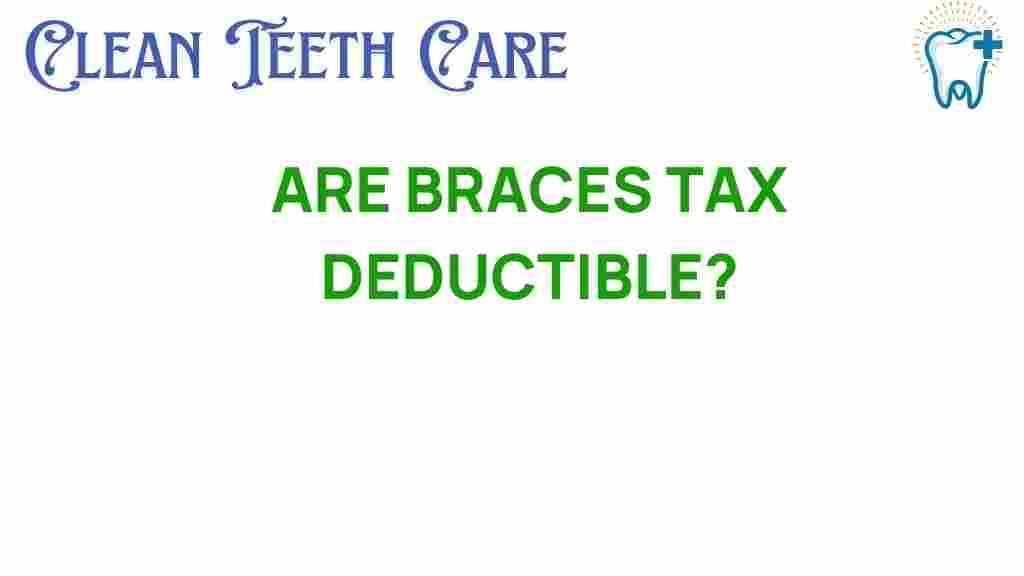Are Braces Tax Deductible? Uncovering Hidden Financial Benefits
When it comes to managing personal finance, understanding the potential for tax deductions can lead to significant savings. One area many individuals overlook is the tax deduction related to dental expenses, specifically orthodontics like braces. If you or your child are considering braces, you may be wondering if these costs can be tax-deductible. In this article, we will explore the IRS guidelines on braces and how you can leverage health savings accounts and other strategies to potentially reduce your medical costs.
Understanding Tax Deductions for Dental Expenses
The IRS allows taxpayers to deduct certain medical expenses, including those related to dental care. However, not all expenses qualify, and it’s essential to understand what is included under the umbrella of dental expenses.
- Braces and orthodontic treatments
- Routine dental check-ups
- Fillings, crowns, and other restorative treatments
- Extractions and surgical procedures
To qualify for a tax deduction, your total medical expenses, including dental expenses, must exceed 7.5% of your adjusted gross income (AGI) for the tax year.
Step-by-Step Process to Claiming Braces as a Tax Deduction
If you believe your braces expenses qualify, follow these steps to ensure you can claim the deduction:
- Keep Detailed Records: Maintain all receipts related to orthodontic treatments. This includes the cost of braces, consultations, adjustments, and any related dental expenses.
- Consult with Your Orthodontist: Ask your orthodontist for a detailed invoice that outlines the total cost of treatment. This invoice will be necessary for your records.
- Calculate Your Medical Expenses: Total your medical expenses for the tax year, including braces and other dental care. Ensure that this total exceeds 7.5% of your AGI.
- Fill Out the Appropriate Tax Forms: Use IRS Form 1040 and Schedule A to report your itemized deductions. Make sure to include your total medical expenses, highlighting those related to orthodontics.
- Consult a Tax Professional: If you’re unsure about any part of the process, it may be beneficial to consult with a tax professional for guidance.
Understanding IRS Guidelines for Medical Expenses
The IRS has specific guidelines regarding what qualifies as a deductible medical expense. Here are some key points to consider:
- Only expenses that exceed 7.5% of your AGI are deductible.
- You must itemize your deductions to claim medical expenses, which means foregoing the standard deduction.
- Expenses must be incurred during the tax year you are filing for.
It’s crucial to familiarize yourself with these guidelines to ensure you are accurately reporting your dental expenses.
Using Health Savings Accounts (HSAs) for Orthodontic Costs
If you have a Health Savings Account (HSA), you can use these funds to pay for braces and other qualified medical expenses. Here’s how it works:
- Tax Benefits: Contributions to HSAs are tax-deductible, and withdrawals for qualified medical expenses are tax-free.
- Flexibility: HSAs can be used for a variety of medical expenses, including dental care, making them a great financial tool.
- Roll Over Funds: Unlike Flexible Spending Accounts (FSAs), HSA funds roll over year to year, allowing you to save for future expenses.
Using an HSA can significantly reduce your overall medical costs associated with braces.
Common Questions About Braces and Tax Deductions
1. Are braces for adults tax-deductible?
Yes, braces for adults can qualify as a tax deduction as long as they meet the IRS guidelines for medical expenses.
2. Can I claim dental expenses if I don’t itemize deductions?
No, you must itemize your deductions to claim any dental expenses. If you take the standard deduction, you cannot claim these expenses.
3. What if my employer offers a flexible spending account (FSA)?
Like HSAs, FSAs can be used for orthodontic expenses. Check your employer’s guidelines to see if braces can be reimbursed through your FSA.
Tips for Maximizing Your Tax Deductions
To ensure you are taking full advantage of available tax deductions, consider these tips:
- Plan Treatments Wisely: If possible, schedule treatments within the same tax year to maximize your deductible expenses.
- Combine Expenses: If you have multiple family members with dental needs, try to consolidate expenses to exceed the 7.5% AGI threshold.
- Review IRS Publications: Familiarize yourself with IRS Publication 502, which provides detailed information about medical expenses.
Troubleshooting Common Issues
While preparing your tax return, you might encounter some challenges. Here are solutions to common issues:
- Missing Receipts: If you have lost receipts, contact your orthodontist for duplicates.
- Not Meeting the AGI Threshold: If your expenses do not exceed the threshold, keep detailed records for the following year as you may surpass it in future years.
- Confusion About Eligible Expenses: If unsure about what qualifies, consult a tax professional or refer to the IRS guidelines.
Conclusion: Uncovering Financial Benefits of Braces
Understanding whether braces are tax-deductible can uncover hidden financial benefits that can ease the burden of dental expenses. By following the IRS guidelines for tax deductions, utilizing health savings accounts, and keeping meticulous records, you can potentially save a significant amount on your tax return. Whether you are considering braces for yourself or your family, being informed about your options can make a substantial difference in your overall personal finance.
For more information on tax deductions and managing your medical costs, be sure to check out the IRS official website for the latest updates and guidance. Additionally, consider speaking with a financial advisor for personalized advice tailored to your situation.
This article is in the category Treatments and created by CleanTeethCare Team
